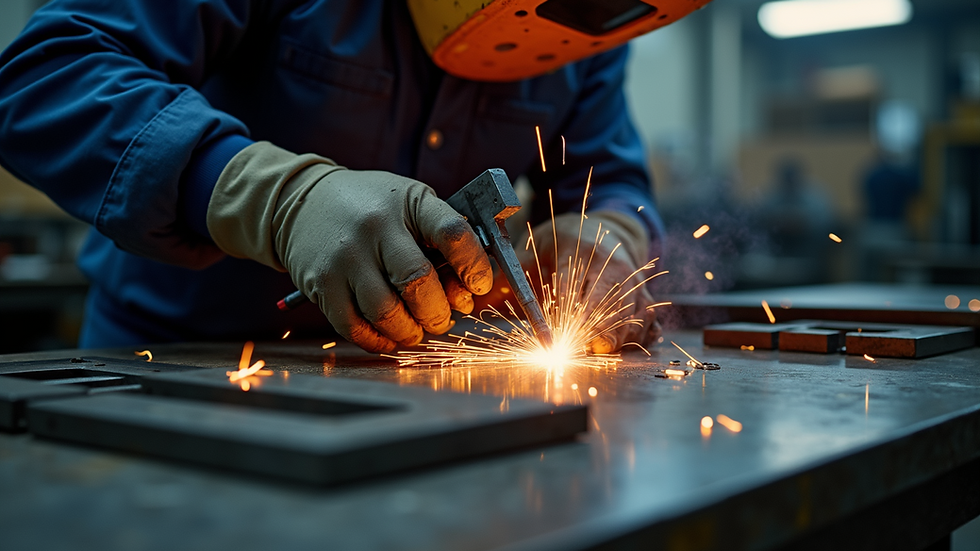Unlocking the Potential of Custom Fabrication
- Rob Perhamus

- Sep 8
- 4 min read
Ever wonder how your wildest ideas can turn into real, tangible things? That’s the magic of custom fabrication. It’s not just about making stuff; it’s about creating exactly what you need, how you want it. Whether you’re dreaming up a unique art piece, building a prototype, or crafting a one-of-a-kind gadget, custom fabrication opens doors you didn’t even know existed. Let’s dive into why this approach is a game-changer and how you can unlock its full potential.
Why Custom Fabrication Benefits Everyone
Custom fabrication benefits are huge, especially when you want something that stands out or fits perfectly. Off-the-shelf products can be limiting. They might not match your vision or meet your exact needs. That’s where custom fabrication shines. It gives you control, flexibility, and precision.
Here’s what you get with custom fabrication:
Tailored solutions: Your project gets made to your exact specs.
Better quality: Focus on materials and craftsmanship that matter to you.
Innovation boost: Try new ideas without being boxed in by standard designs.
Cost efficiency: Avoid paying for features or parts you don’t need.
Faster iteration: Make changes quickly and see your ideas evolve.
Imagine you’re an artist wanting a sculpture with a specific metal finish and shape. Or an entrepreneur needing a prototype that fits a unique space. Custom fabrication lets you bring those visions to life without compromise.

How Custom Fabrication Works in Real Life
So, how does this all come together? Custom fabrication is a process that starts with your idea and ends with a finished product made just for you. It usually involves several key steps:
Concept and design: Sketch your idea or work with a designer.
Material selection: Choose the best materials for strength, look, or function.
Prototyping: Build a test version to check fit and function.
Fabrication: Use tools like CNC machines, laser cutters, or welding to create parts.
Assembly and finishing: Put everything together and add final touches.
Each step is a chance to tweak and improve. For example, if you’re an engineer building a custom machine part, you can test different materials or shapes before finalizing. This hands-on approach saves time and money in the long run.
If you want to explore this further, check out custom design and fabrication services that help you every step of the way.

What is the difference between design and fabrication drawings?
This is a question I get a lot. Design drawings and fabrication drawings might seem similar, but they serve different purposes.
Design drawings focus on the overall look and function. They show how the final product should appear and work. These are often more conceptual and used to communicate ideas.
Fabrication drawings are detailed and technical. They include exact measurements, materials, and instructions for making each part. These drawings guide the fabricators during production.
Think of design drawings as the blueprint of your dream, while fabrication drawings are the step-by-step recipe to cook it up. Both are essential, but fabrication drawings ensure your vision becomes reality without guesswork.
For example, if you’re creating a custom furniture piece, the design drawing might show the style and dimensions, while the fabrication drawing breaks down every joint, screw, and cut needed.

Tips to Maximize Your Custom Fabrication Experience
Ready to jump in? Here are some practical tips to get the most out of custom fabrication:
Be clear about your goals: Write down what you want your project to achieve. This helps avoid confusion later.
Communicate openly: Work closely with fabricators or designers. Ask questions and share feedback.
Start small: Build a prototype or sample first. It’s easier to fix issues early.
Choose the right materials: Think about durability, cost, and appearance.
Plan your budget: Custom work can be more expensive, but it’s worth it for quality and fit.
Use local resources: If you’re near Upland, Claremont, Ontario, or La Verne, tap into local makerspaces and fabrication shops. They often offer workshops and support.
By following these steps, you’ll avoid common pitfalls and enjoy a smoother process from idea to finished product.
Why Local Makerspaces Are Your Secret Weapon
One of the best ways to unlock custom fabrication benefits is by connecting with local makerspaces. These community hubs provide access to tools, expertise, and a network of creative people. Places like UMakers are perfect for anyone looking to turn ideas into reality.
Here’s why local makerspaces rock:
Access to equipment: CNC machines, 3D printers, laser cutters, and more.
Expert guidance: Learn from experienced fabricators and designers.
Collaborative environment: Share ideas and get inspired by others.
Cost-effective: Use expensive tools without buying them yourself.
Workshops and classes: Build your skills and confidence.
If you’re in the Upland, Claremont, Ontario, or La Verne areas, UMakers is a fantastic resource. They help freelancers, artists, engineers, entrepreneurs, and hobbyists like you bring projects to life.
Custom fabrication is more than just making things. It’s about creating solutions that fit your unique vision and needs. With the right approach, tools, and community, you can unlock endless possibilities. So, what will you build next?




























Comments